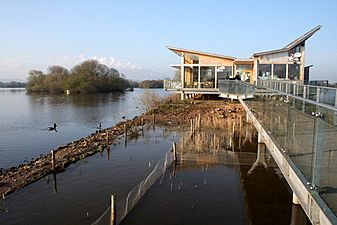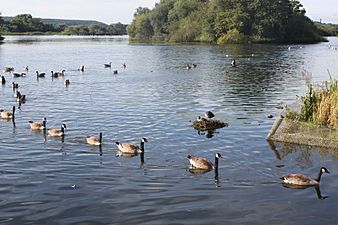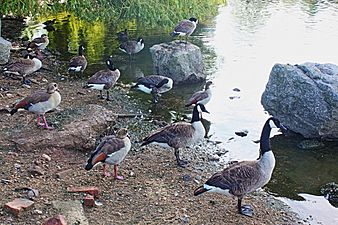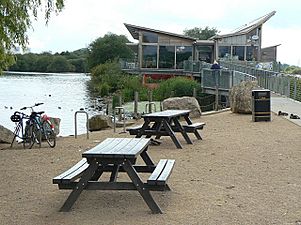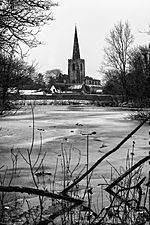Attenborough Nature Reserve facts for kids
Quick facts for kids Attenborough Nature Reserve |
|
|---|---|
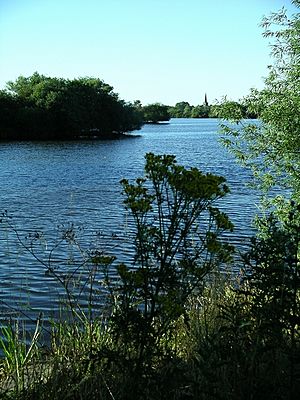
Attenborough Nature Reserve looking across one of the flooded gravel pits towards Attenborough village
|
|
| Lua error in Module:Location_map at line 420: attempt to index field 'wikibase' (a nil value). | |
| Location | Attenborough, Nottinghamshire, England |
| Nearest city | Nottingham |
| Area | 145 hectares (360 acres) |
| Created | 1966 |
| Owned by | Nottinghamshire Wildlife Trust |
| Open | 7:00am to dusk |
| Status | SSSI (for map see Map) |
Attenborough Nature Reserve is a special place in Attenborough, England. It is a nature reserve where plants and animals are protected. You can find it about 7 kilometers (4.3 miles) southwest of Nottingham city center.
The reserve is looked after by the Nottinghamshire Wildlife Trust. They bought it in December 2020. At the heart of the reserve is the Attenborough Nature Centre. This building helps visitors and offers fun learning programs.
Contents
Discovering Attenborough Nature Reserve
How the Reserve Started
The land where the reserve now sits was once used for digging up gravel. This happened between 1929 and 1967. The company that owned it, CEMEX, still digs for sand and gravel nearby.
As parts of the land were used up, they were turned back into wetlands. This means areas with water, like marshes and ponds. In 2010, a section called Thrumpton's Land was restored this way.
The nature reserve officially opened in 1966. It was opened by the famous naturalist and TV presenter, Sir David Attenborough.
Saving the Reserve
In 2019, the owners wanted to sell the land. People worried about the future of the reserve. So, an appeal was started to raise money. Sir David Attenborough, whose family comes from this area, helped with the appeal.
They needed one million pounds to buy the land. This would allow the Nottinghamshire Wildlife Trust to own it. The Trust had already helped care for the site for 60 years.
In December 2020, the purchase was completed. A large grant of £750,000 from the Biffa Award helped make this possible.
Exploring the Reserve's Nature
What You'll Find Here
Today, Attenborough Nature Reserve covers 145 hectares (358 acres). This huge area includes many lakes, wetlands, grassy fields, and bushy areas. It is located where two rivers meet: the River Erewash and the Trent.
The reserve is part of a bigger area called the Attenborough Gravel Pits Site of Special Scientific Interest (SSSI). An SSSI is a special place in the UK. It is protected because it has rare wildlife or geology. This SSSI covers 226.6 hectares (560 acres).
The Ponds and Wildlife
The large lakes were formed from the old gravel pits. They have names like Church Pond, Clifton Pond, Main Pond, Tween Pond, and Beeston Pond. There are also drier areas with trees and bushes.
These ponds are very important for birds. Many birds come here to spend the winter. This includes birds like shovellers and diving ducks. Since 1966, over 250 different types of birds have been seen here!
Some very rare birds have also visited the reserve. These include the European penduline tit (seen in 1994) and the squacco heron (seen in 1998 and 2011). Other rare visitors were the purple heron (in 2003) and the sora (in 2004).
Visitor Facilities
The Nature Centre
The Attenborough Nature Centre is a great place to start your visit. It offers educational programs for learning about nature. There is also a shop and a place to get refreshments. You can park your car here too.
The center was finished in 2005. It even won a Gold award for being an "eco-tourism" spot. This means it is very friendly to the environment. Sir David Attenborough returned to open the center, almost 40 years after opening the reserve itself.
A magazine called BBC Wildlife listed the center as one of the top ten "eco places in the world." The center is open every day of the week. It is surrounded by the beautiful ponds. There are also two public bird hides. These are special shelters where you can watch birds without disturbing them.
Gallery
-
Canada geese swimming in line
-
Egyptian and Canada geese together
-
St Mary's Church over a frozen lake


